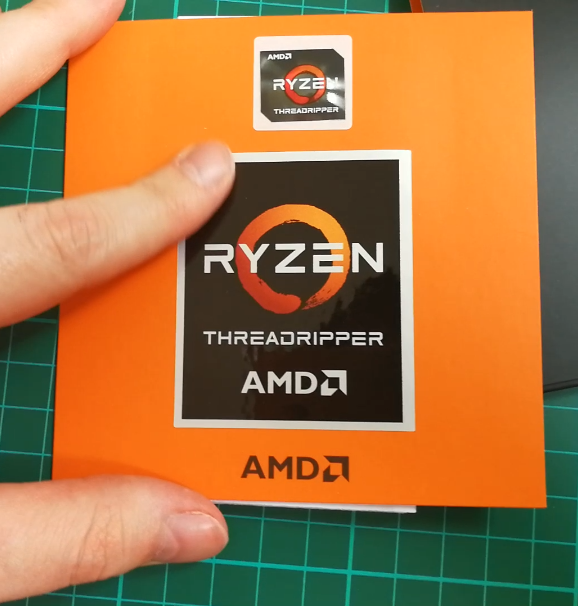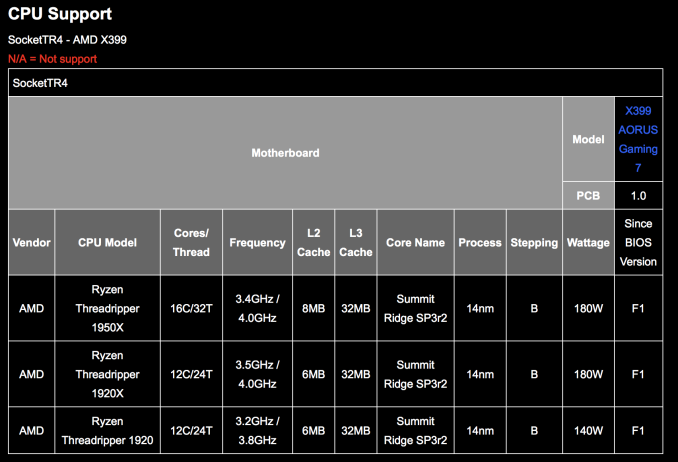Unannounced AMD Ryzen Threadripper 1920 CPU in Motherboard Support Lists
by Anton Shilov on August 7, 2017 9:00 AM EST- Posted in
- CPUs
- AMD
- AM4
- Ryzen
- ThreadRipper
- ThreadRipper 1920
- TR 1920

Three leading makers of motherboards on Friday disclosed specifications of yet-unannounced AMD Ryzen Threadripper 1920 processor. The chip has 12 cores, works at slightly lower frequencies than the model 1920X, but also comes with a lower TDP. Unfortunately, it is unknown when the product is set to become available.
So far AMD has publicly introduced three microprocessors in its family of CPUs for super high-end desktops/workstations: the Ryzen Threadripper 1950X (16 cores, 3.4 GHz), the Ryzen Threadripper 1920X (12 cores, 3.5 GHz), and the Ryzen Threadripper 1900X (8 cores, 3.8 GHz base). AMD has never made any announcements regarding any other members in the Ryzen Threadripper family, or if three would be the limit - and it appears there is at least one more incoming. According to CPU support lists of the ASUS ROG Zenith Extreme, ASRock X399 Professional Gaming/X399 Taichi as well as GIGABYTE X399-Gaming 7, which were published this week, the 1920 (without an X) will also make a showing.

From the GIGABYTE X399 Gaming 7 Support Page
The Ryzen Threadripper 1920 will have 12 cores with simultaneous multithreading, a 3.2 GHz base frequency, a 3.8 GHz turbo frequency, and the full 32 MB of L3 cache. The differences between the 1920 and the 1920X are lower clock rates and AMD’s XFR speed boost on the 1920: typically Ryzen CPUs without the X have half the XFR.
Another difference is that the AMD Ryzen Threadripper 1920 will have a 140 W TDP, down from 180 W of the higher-end models, due to the lower frequency settings. This is for similar reasons as the 95W/65W TDP differences between the 1700X and 1700. The lower clock speed of the 1920 should be indicative of a slightly lower level of performance than the 1920X, and should mean that it will be cheaper than the 1920X ($799), but somewhat more expensive than the Threadripper 1900X ($549).
| AMD Ryzen SKUs | |||||||||
| Cores/ Threads |
Base/ Turbo |
XFR | L3 | DRAM 1DPC |
PCIe | TDP | Cost | Cooler | |
| TR 1950X | 16/32 | 3.4/4.0 | ? | 32 MB | 4x2666 | 60 | 180W | $999 | - |
| TR 1920X | 12/24 | 3.5/4.0 | ? | 32 MB | 4x2666 | 60 | 180W | $799 | - |
| TR 1920 | 12/24 | 3.2/3.8 | ? | 32 MB | 4-Ch(?) | 60 | 140W | ? | - |
| TR 1900X | 8/16 | 3.8/4.0 | +200 | ? | 4-Ch(?) | 60 | ? | $549 | - |
| Ryzen 7 1800X | 8/16 | 3.6/4.0 | +100 | 16 MB | 2x2666 | 16 | 95 W | $499 | - |
| Ryzen 7 1700X | 8/16 | 3.4/3.8 | +100 | 16 MB | 2x2666 | 16 | 95 W | $399 | - |
| Ryzen 7 1700 | 8/16 | 3.0/3.7 | +50 | 16 MB | 2x2666 | 16 | 65 W | $329 | Spire |
| Ryzen 5 1600X | 6/12 | 3.6/4.0 | +100 | 16 MB | 2x2666 | 16 | 95 W | $249 | - |
| Ryzen 5 1600 | 6/12 | 3.2/3.6 | +100 | 16 MB | 2x2666 | 16 | 65 W | $219 | Spire |
| Ryzen 5 1500X | 4/8 | 3.5/3.7 | +200 | 16 MB | 2x2666 | 16 | 65 W | $189 | Spire |
| Ryzen 5 1400 | 4/8 | 3.2/3.4 | +50 | 8 MB | 2x2666 | 16 | 65 W | $169 | Stealth |
| Ryzen 3 1300X | 4/4 | 3.5/3.7 | +200 | 8 MB | 2x2666 | 16 | 65 W | $129 | Stealth |
| Ryzen 3 1200 | 4/4 | 3.1/3.4 | +50 | 8 MB | 2x2666 | 16 | 65 W | $109 | Stealth |
The fact that the Ryzen Threadripper 1920 is already supported by motherboards probably means that one can expect its launch in the coming weeks or months, but perhaps not right after the Ryzen Threadripper 1920X and the 1950X that land on August 10. Meanwhile, an interesting point to add here is that the CPU support lists from ASUS, ASRock and GIGABYTE do not indicate they support the 1900X with eight cores, which is announced to be on shelves on August 31st.
Related Reading
- AMD Ryzen Threadripper 1950X and 1920X: We’re Allowed To Show Pictures Now
- The AMD Zen and Ryzen 7 Review: A Deep Dive on 1800X, 1700X and 1700
- The AMD Ryzen 5 1600X vs Core i5 Review: Twelve Threads vs Four at $250
- The AMD Ryzen 3 1300X and Ryzen 3 1200 CPU Review: Zen on a Budget
- AMD Launches Ryzen PRO CPUs: Enhanced Security, Longer Warranty
- How To Get Ryzen Working on Windows 7 x64
- AMD Launches Ryzen: 52% More IPC, Eight Cores for Under $330
Sources: Motherboard Makers via Hexus.














21 Comments
View All Comments
baka_toroi - Monday, August 7, 2017 - link
What do you mean there's no 10nm from AMD? You mean, like, ever? In that case what I meant is if it will be worth waiting for the next process shrink, be it 8nm, 7nm or 5nm.DanNeely - Tuesday, August 8, 2017 - link
That's exactly what he means. GloFo is intending to call its next process 7nm. (The name of a process has gradually stopped having anything to do with the size of the features it makes over the last decade. Not only does # nm not mean all the bits are # nm in size, but processes of different manufacturers have significantly different feature sizes even if named the same. If GloFo is actually planning ~2x linear shrinks between 14 and 7nm or has just decided to go for the smallest marketing number crown is TBD.)BurntMyBacon - Tuesday, August 8, 2017 - link
The process size never meant that all the bits were that size. The process size is used to represent the smallest feature size the process is capable of producing. These feature sizes only get used on transistors with light loads as they aren't large enough to drive high capacitance loads at the speeds demanded of them. Logic circuits without heavy branching that need to run high speed will get smaller transistors. Clock distribution, line buffers, and transistors driving multiple targets will have larger transistors. In short, transistor sizes are adjusted according to loading in order to achieve the optimal switching speeds.To your point, though, the methods different companies or even the same company over different generations use to determine process size has become increasingly disparate.
jstein - Monday, August 7, 2017 - link
180w is the maximum. You could easily run lower than this. Look at Skylake-X in this chart:http://www.anandtech.com/show/11550/the-intel-skyl...
Lower power consumption is one of Zen's biggest achievements. The R7s are 8-core chips running between 65w and 90w. Meanwhile, any 6+ core chip from Intel is 100w+, and their latest 6-core is pushing 150w even though the TDP is 140. X399 truly is a step above X299 in performance and features, so the TDP is above it as well. What Ryzen has done is made people looking at Intel HEDT platform consider buying an R7 instead. Only the heaviest users should get TR.
Tewt - Tuesday, August 8, 2017 - link
Agreed on Zen's lower power consumption. I don't get the other comment saying Zen architecture has "insane TDP." It sounds like the poster has no intention of buying any Zen products and makes me wonder why they are even posting if so one sided other than to throw some fud around. I can buy AMD without bashing Intel and recognize they make a good product(but just not in my price range).BrokenCrayons - Tuesday, August 8, 2017 - link
It's perfectly reasonable to note that a 180W TDP is insanity. That is a vendor-neutral statement. I would point out the same problem were it Intel releasing a CPU with the same TDP. In fact, Skylake-X is up there as well with a stupidly high TDP. We've seen significant improvements in power and heat output of a variety of chips and there's no excuse for the sudden dogpile on the top aside from idiotic competition in overpriced high-end parts that only benefit a company through their halo effect on more reasonable components that consumers actually will purchase in significant numbers. It's happening in the GPU market as AMD and NV pointlessly chase the performance crown as demonstrated by Vega's outrageous TBP. I'm merely pointing out that as technology has improved, we ought to be able to get really good performance out for a lot less waste heat and electrical power, but we're not. I want a passively cooled desktop that's a high performance machine just like my old 368DX that was a blazing fast system without even so much as a heatsink attached to the processor. Instead, I need a heat pipe festooned tower with two 120mm fans in push-pull config just for the CPU alone and nevermind about the dual slot blower grafted to the video card or the dumb RGB-LED foo-fighter heat spreaders on the RAM. The computer industry has gone off the moronic deep end and you kids can get off my lawn now!Manch - Tuesday, August 8, 2017 - link
Intel's Skylake X is 6-18 core 140-160W. I don't see the issue with ZEN power efficiency. Plus look at the tests and wattage during loads. Nothing wrong their. VEGA though....sigh...shabby - Monday, August 7, 2017 - link
1950 coming soon too... obviously.yannigr2 - Monday, August 7, 2017 - link
It's easy to guess how this will go1950 at $899,
1920 at $699,
1900 at $499.
msroadkill612 - Monday, August 7, 2017 - link
"The differences between the 1920 and the 1920X are lower clock rates and AMD’s XFR speed boost on the 1920: typically Ryzen CPUs without the X have half the XFR."? Not a clear explanation.